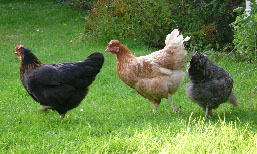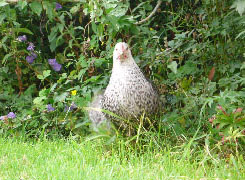
Happy Chickens
I love chickens. They are very pleasant creatures, with a friendly calming disposition and can be kept for their utterly delicious eggs even in a relatively small garden. Also one moderately sized bird (about 4lb / 1.9kg) can make several economical meals if it is used to its full potential.
I based the following on feeding a family of four.
DAY 1: ROAST CHICKEN
1. Pre-heat the oven to 200 / 400 / 6
2. Stuff with Simple Stuffing detailed below
3. Sprinkle the chicken with mixed herbs and a little paprika.
4. If you hate cleaning your oven, wrap the chicken in foil and put it in a roasting tin
5. Place in the oven for 20 minutes
6. Turn the heat down to about 140 / 275 /1 and cook for about an hour
7a. If you’re using foil, turn the heat up to 200 / 400 / 6 again and open up the foil on top and put the bird back in to crisp up for 10 minutes. To test if the chicken is cooked, dig a fork deeply into the bit between the leg and the body. If the juices run clear then it’s cooked. If they are pink or have red bits in, give another 15 minutes and then test again. Presuming the chicken is cooked, go to 7b.
7b. If you’re not using foil, turn the oven off and leave to rest in a warm place for 15 minutes while you cook the vegetables.
8. Carve all the meat off the chicken and set aside half of it for the next day. Keep the bones, you’re going to need them.
9. Remove all the stuffing and serve on a plate with the carved roast chicken. Anything that isn’t eaten is gorgeous in a sandwich with jam or redcurrant jelly. Really.
Serve with boiled or roast potatoes and at least two different kinds of lightly cooked vegetables and use the vegetable water for the gravy.
If there are any leftover bones and skin add them to the other bones for stock.
SIMPLE STUFFING
1 onion – medium, finely chopped
1 good knob of butter
8oz (250g) sausagemeat
1 tbsp chopped fresh parsley or ½ tbsp dried parsley
1 tbsp chopped fresh sage or ½ tbsp dried sage
Juice of 1 lemon or 2 tbsp bottled lemon juice
Method
1. Melt the butter in a saucepan over a medium heat and soften the onions until translucent. Take the pan off the heat.
2. Add all the other ingredients and mix well with your hands, really squishing it all together.
3. Stuff it inside the cavity of the chicken.
NB: If you’re feeling saucy, how about adding a small tin of chestnuts, chopped, to the mixture. A couple of garlic cloves add a bit of zing as well.
Tomorrow, I’ll tell you how to use the remaining half of the chicken for a tasty peasant style Italian Risotto that is equally nice for vegetarians if you leave out the chicken.
STOCK
1. Put all the remaining bones and skin into a large pan and cover with water. Pop in a bay leaf and some 6 peppercorns.
2. For a light stock, simmer gently on a low heat for 3-4 hours with a few pieces of chopped carrot, a bit of celery and a bit of onion. Strain and use as required..
For a heavier stock follow step one, but keep it simmering for a couple of days, topping up the water, adding any vegetable water you have, and any other bones until the stock is quite dark. Strain and use as required.
* * *
Before I sign off, there must be a Word about Welfare. I know that it is very tempting to buy two chickens for £5 in the supermarket. Before you do, have a look at the http://www.chickenout.tv website. It is impossible to produce a chicken for £2.50 if it has been cared for properly, with freedom to move, to peck, to roost, socialise and been fed a natural diet. Chicken doesn’t necessarily have to be completely free range, although obviously that is what we should all be aiming for, but there are plenty of chickens available that have natural light and freedom to roam but which aren’t actually free range. Yes, they cost more than £2.50 each but a decent chicken will last three meals and I truly believe that with a properly produced bird, who has had time to mature naturally, you don’t actually need to eat as much. And one more thing. Before anyone suggests that they can’t afford it, the Wartime Housewife lives on a lower income than most of you can possibly imagine but I would rather go without chicken than eat an animal who has had a miserable life.
Look out for future blogs on meat buying and cooking with cheaper cuts.
May I extend my grateful thanks to Mr de Worde who kindly sent the photographs of his very beautiful and very happy chickens.

Inquisitive Chicken

Three Happy Chickens

























